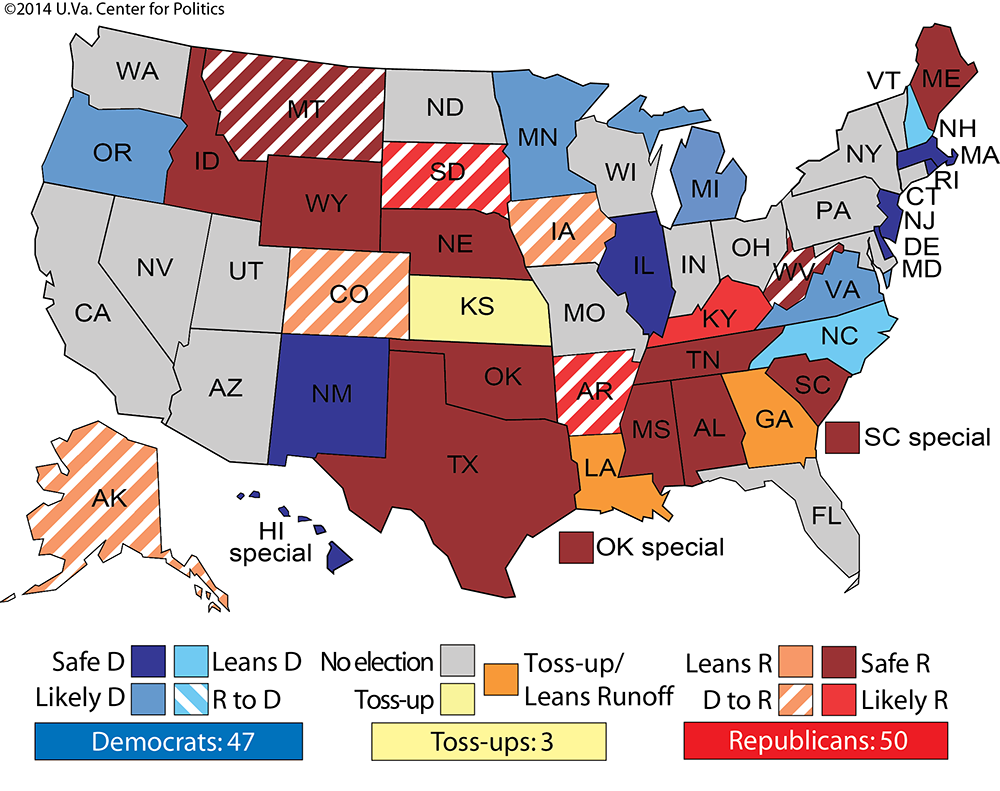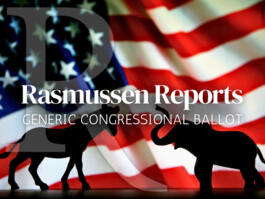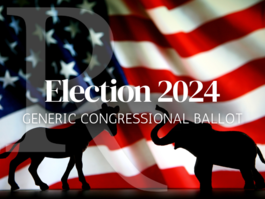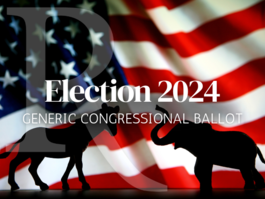Bet on a Republican Senate Majority
A Commentary By Larry J. Sabato, Kyle Kondik and Geoffrey Skelley
Join the Crystal Ball team Monday night at the University of Virginia for a free presentation on the 2014 midterms. Visit the U.Va. Center for Politics website for more information and to register to attend. |
A version of this article originally appeared in Politico Magazine Wednesday evening.
While many races remain close, it’s just getting harder and harder to envision a plausible path for the Democrats to retain control of the Senate. Ultimately, with just a few days to go before the election, the safe bet would be on Republicans eventually taking control of the upper chamber.
We say eventually because there’s a decent chance we won’t know who wins the Senate on Election Night. Louisiana is guaranteed to go to a runoff, and Georgia seems likelier than not to do the same. The Georgia runoff would be Jan. 6, 2015, three days after the 114th Congress is scheduled to open. Vote-counting in some states, like Alaska, will take days, and other races are close enough to trigger a recount.
Generally speaking, candidates who have leads of three points or more in polling averages are in solid shape to win, but in this election five states — Republican-held Georgia and Kansas, and Democratic-held Iowa, New Hampshire, and North Carolina — feature a Senate race where both of the two major polling averages (RealClearPolitics and HuffPost Pollster) show the leading candidate with an edge of smaller than three points.
What makes the Democrats’ situation so precarious is that Republicans have polling leads of more than three points in five other states, all of which are currently held by Democrats: Arkansas, Louisiana, Montana, South Dakota, and West Virginia. Two others, Democratic-held Alaska and Colorado, show Republicans leading in both averages, but by more than three points in just one. (These averages are as of Wednesday afternoon.)
The wealth of GOP targets is a reflection of the structural advantages that have favored Republicans in this election, some of which don’t have anything to do with a specific campaign.
Those are:
Obama’s troubles: President Obama’s approval ratings are in the low 40s, and midterm elections are very often a vote against the party that occupies the White House, particularly if the occupant is unpopular.
A great map: This Senate map is the most-Republican leaning of the three Senate classes up for election once every six years. These seats were last on the ballot in 2008, a big Democratic year. American politics is about surges and declines: In 2008 came the surge for Democrats, and in 2014 comes the decline.
Partisan polarization: The increasing partisanship of American politics and the American people makes it harder and harder for Democrats to win in Republican states and districts, and vice-versa. Seven Democrats hold Senate seats contested this year in states that supported Mitt Romney in 2012. Six of those states are very Republican at the presidential level — Alaska, Arkansas, Louisiana, Montana, South Dakota and West Virginia — and Republicans are probably at least slightly favored to win all six of their Senate races. The seventh, North Carolina, is gettable if the GOP has a big night. Republicans only have to defend one seat in an Obama state, Maine, and GOP Sen. Susan Collins has the race all but wrapped up.
Democratic difficulties: The Democrats had a string of Senate retirements in places like Iowa, Montana, South Dakota, and West Virginia, all of which improved Republican odds to win those states. The replacement Democratic candidates in these states have generally been poor, none more so than appointed Sen. John Walsh, whose plagiarism forced him from the ballot in Montana and prompted the Democrats to wave the white flag in a Senate seat they had never lost since the advent of popular Senate elections a century ago.
Decent GOP candidates: Establishment-backed Republicans won basically every meaningful Senate primary this year. While some Republican candidates have misfired, like Terri Lynn Land in Michigan, the GOP has not had a clearly disastrous candidacy turn victory into defeat in any single state, unlike 2010 and 2012 — although David Perdue in Georgia and Thom Tillis in North Carolina are testing this proposition. To the contrary, the Senate candidate this cycle most associated with gaffes is a Democrat, Bruce Braley of Iowa.
Those big factors all point to a good night for Republicans on Tuesday.
Map 1: Crystal Ball Senate ratings
The GOP’s many paths to 51
The Senate math starts with the seats that are not up this cycle and the safe seats that are not on the verge of flipping parties. Of the 83 seats that fit those categories, 42 are held by Republicans and 41 by Democrats.
Democratic incumbents in Minnesota, Oregon, and Virginia all occupy seats we rate Likely Democratic, and Rep. Gary Peters (D) is well positioned to keep the open seat in Michigan in Democratic hands. These four holds put Democrats at 45 seats.
Republicans have two surefire pickups in Montana and West Virginia, and they can probably count on South Dakota, too. This is a ratings change for the Crystal Ball — we’re moving the Mount Rushmore State from Leans Republican to Likely Republican. Ex-Gov. Mike Rounds’ (R) troubles don’t seem sufficiently large enough to open the door for Rick Weiland (D) or ex-Republican Sen. Larry Pressler, whose position in the race has faded to some degree. We also rate both the Kentucky and Arkansas races as Likely Republican, with the Razorback race providing the GOP with its fourth pick-up. Accounting for these contests, Republicans are at 47 seats in our calculus.
Now this is where things get murkier. Alaska, Colorado, and Iowa appear to be edging toward Republicans. In our Crystal Ball ratings, we’ve had both Alaska and Iowa leaning to the Republicans, and we continue to do so even though there’s uncertainty in both states, Alaska in particular: If any Democrat confounds the polls, it could be Sen. Mark Begich (D). Iowa is also close, although state Sen. Joni Ernst (R) has consistently held a small lead in public polling, and Democrats are sounding alarms about Rep. Bruce Braley’s performance in the state’s two eastern, more Democratic-leaning congressional districts. Additionally, their vaunted early voting machine might not be as dominant this year. The tea leaves in this race do not augur well for the Democrats.
Polling in Colorado misfired in both 2010 and 2012, underestimating the Democratic vote in both years, and Democrats are banking on a similar mishap, along with the state’s new all-mail balloting boosting Democratic turnout, delivering an upset victory for Sen. Mark Udall (D), who trails in nearly all independent polling to Rep. Cory Gardner (R). That is possible, but there is also reason to be skeptical. For one thing, Gardner is unquestionably a superior candidate to Ken Buck, the Republican who fumbled the 2010 race against Sen. Michael Bennet (D). And some pollsters have no doubt learned from their past mistakes. Gardner’s lead in polling averages is around three points, right around where we’d expect him to be to have a good shot of winning. So we’re calling Colorado Leans Republican, now, too, to go along with Alaska and Iowa.
Are we supremely confident about these three very tight match-ups? Of course not: each one is a crap shoot. It’s possible we might reverse a call or two before our final picks appear on Monday; in squeakers, last-minute trends matter.
Adding these close races to the GOP total puts Republicans at 50 Senate seats, one shy of a majority.
New Hampshire and North Carolina still lean to the Democrats. The latter contest is particularly close at this point, though Sen. Kay Hagan (D) still retains a slim lead over Thom Tillis (R). Even though he’s made up considerable ground in New Hampshire, a victory by former Massachusetts Sen. Scott Brown (R) would still rank as mildly surprising — and a sure-fire indicator of a big GOP night. For now, though, the Democrats are narrowly ahead, and that makes the Democratic total 47 seats.
Complicating matters are the two contests that we rate as Toss-up/Leans Runoff, meaning that we can’t pick a final winner at this point because we expect overtime. In Georgia there are enough undecided voters to push either David Perdue (R) or Michelle Nunn (D) over the top on Nov. 4, but it won’t be easy. Let’s say for the moment that both Louisiana and Georgia go to runoff. They are red states, though the Peach State is turning plum-purple. Nonetheless, it seems reasonable to expect the GOP to win at least one of these two seats (if not both) in the end. That would get the Republicans to their magic number, 51, or even 52.
Finally, there’s one seat we still view as a pure toss-up: Kansas. That’s not only because the race is very tight, but also because it’s hard to say with which party independent Greg Orman would caucus if he defeats Sen. Pat Roberts (R). A victorious Orman is going to play the Senate version of “Let’s Make a Deal,” and both parties will be putting rich prizes behind Doors 1 and 2.
If we give Democrats most of the breaks in the close contests, it’s certainly possible they could achieve a 50-50 Senate split, and thus a Biden majority (with the vice president breaking the tie in their favor). Yet given the fundamentals of the 2014 cycle, that outcome remains unlikely. The Republicans have more credible paths to 51 than the Democrats do to 50. This was true in January and it is still true just days from the election.
Table 1: Crystal Ball Senate ratings changes
Conclusion
Prof. James Campbell of the University at Buffalo-SUNY recently noted that in Senate races “since 1912, of the 14 midterms in a party’s second presidential term or more, the out-party has gained six seats or more nearly two-thirds of the time (9 of 14).” In other words, a GOP Senate takeover in a president’s sixth-year midterm would be very much in line with history — and with the roughly “two out of three” chance for a Republican majority that we have asserted for months.
Even though the GOP is poised to do well in the Senate, the party’s performance probably will not qualify as a broad-based wave. Though perhaps election watchers will be surprised by the size of Republican gains on Election Night, we expect to see a kind of red-tinged “full-moon high tide” rather than a tsunami. Despite favorable conditions and a near-ideal map, Republicans have had to struggle right to the final hours to position themselves for their Senate majority. The public’s unfavorable view of the GOP, which is even greater than the disgust with Democrats, will likely keep the party from achieving a true sweep — and suggests the hard work ahead by the GOP in Congress and the eventual presidential nominee in 2016.
The 2014 midterm, no matter the outcome, does not hold real predictive value for 2016. We’ve often compared this year with 1986, where Democrats bounced back to capture the Senate on a highly favorable map in President Reagan’s “sixth-year itch” second midterm. Of course, two years later, the country elected a Republican president for the third straight time. Could the current GOP meet with a similar fate? The results next Tuesday certainly won’t tell us.
Alternately, 2014 might prove to be like 2006, a great Democratic year that foreshadowed another great Democratic year. For all the legitimate talk of the Democrats’ growing demographic edge in presidential elections, the advantage could be blunted by an unpopular President Obama, who like then-President George W. Bush could drag down his party in consecutive elections. Obama’s approval rating is very important in the outcome of the next presidential election: If his approval rating continues to stagnate or sinks even lower, his standing will once again imperil Democrats, just as it did in 2010 and 2014. Democrats in and out of Congress will need to find ways to help Obama leave office on a high note, because their fortunes — and that of the Democratic nominee picked to succeed him — will still be linked to his.
But it’s too soon for speculations about the distant future when Tuesday looms large. Check back on Monday for our final picks in Senate, gubernatorial, and House races, which will be posted both at Politico and on the Crystal Ball website.
Larry J. Sabato is the director of the Center for Politics at the University of Virginia.
Kyle Kondik is a Political Analyst at the Center for Politics at the University of Virginia.
Geoffrey Skelley is the Associate Editor at the Center for Politics at the University of Virginia.
See Other Commentary by Larry Sabato
See Other Political Commentary by Kyle Kondik
See Other Political Commentary by Geoffrey Skelley
See Other Political Commentary
Rasmussen Reports is a media company specializing in the collection, publication and distribution of public opinion information.
We conduct public opinion polls on a variety of topics to inform our audience on events in the news and other topics of interest. To ensure editorial control and independence, we pay for the polls ourselves and generate revenue through the sale of subscriptions, sponsorships, and advertising. Nightly polling on politics, business and lifestyle topics provides the content to update the Rasmussen Reports web site many times each day. If it's in the news, it's in our polls. Additionally, the data drives a daily update newsletter and various media outlets across the country.
Some information, including the Rasmussen Reports daily Presidential Tracking Poll and commentaries are available for free to the general public. Subscriptions are available for $4.95 a month or 34.95 a year that provide subscribers with exclusive access to more than 20 stories per week on upcoming elections, consumer confidence, and issues that affect us all. For those who are really into the numbers, Platinum Members can review demographic crosstabs and a full history of our data.
To learn more about our methodology, click here.





